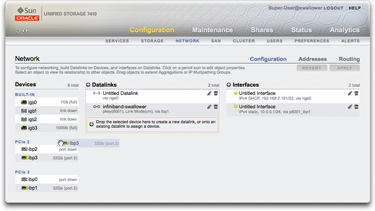Working with Network Configuration
In the appliance model, network devices are created by the system to represent the available network or InfiniBand ports; they have no configurable settings. Datalinks are a layer 2 entity and must be created to apply settings such as LACP to these network devices. Interfaces are a layer 3 entity containing the IP settings, which they make available via a datalink. This model has separated network interface settings into two parts: datalinks for layer 2 settings and interfaces for layer 3 settings.

The Devices column corresponds to the physical network interface card (NIC) ports on the controller and are typically labeled igb0, igb1, igb2, and igb3. Port NET-0 corresponds to device igb0, port NET-1 to igb1, and so on. It is strongly recommended to use one NIC port per controller as a management interface. This column also contains the physical InfiniBand ports on the controller, and are typically labeled ibp0, ibp1, ibp2, and ibp3.
The Datalinks column corresponds to the construct for sending and receiving packets for a specific network device. They support VLANs, VNICs, IB partitions, and LACP aggregation. Datalinks are required to complete network configuration, even if they do not apply specific settings to network devices.
The datalink entity (which we named "aggr1") groups the network devices in a configurable way (LACP aggregation policy). The interface entity (which we named "phobos") provides configurable IP address settings, which it makes available on the network via the datalink. The network devices (named "igb1", "igb2", ..., by the system) have no direct settings.
The Interfaces column corresponds to configurable IP address settings and other properties for datalinks. Interfaces can be available via a single datalink or as defined in an IP MultiPathing (IPMP) group comprising a pool of datalinks, which allows automatic migration of IP addresses from failed to working datalinks.
An example of a single IP address on a single port (common configuration) is:
-
Devices - igb0
-
Datalink - datalink1
-
Interface - deimos (192.168.2.80/22)
The following configuration is for a 3-way link aggregation:
-
Devices - igb1, igb2, igb3
-
Datalink - aggr1 (LACP aggregation)
-
Interface - phobos (192.168.2.81/22)